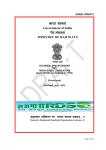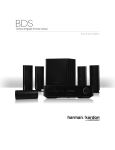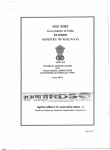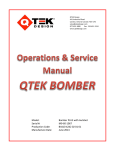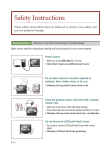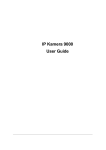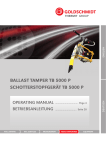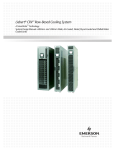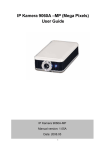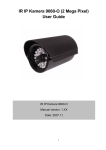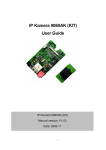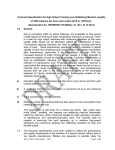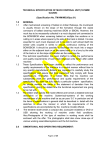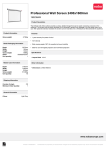Download भारत सरकार Government of India रेलेेे मं ालयंंं
Transcript
भारत सरकार Government of India रे ल मंालय MINISTRY OF RAILWAYS FUNCTIONAL REQUIRNMENT SPECIFICATION For Ultrasonic Broken Rail Detection System (Provisional) अनुसध ं ान, ान अिभकप एवं मानक संगठन, ठन लखनऊ -11 Research, Design and Standards Organization, Lucknow-11 1 1. SCOPE 1.1 This functional requirement specification (FRS) covers the requirements for Ultrasonic Broken Rail Detection System proposed for trial on Indian Railway Network. 1.2 The Broad Gauge (1676mm) Indian Railway network has majority of track structure as UIC 60kg/IRS 52kg long/continuously welded rails welded using Flash butt welds or Alumino-thermic welds laid on pre-stressed mono-block concrete sleepers on stone crushed ballast bed. The phenomenon of breaks in rails/welds is a major safety concern, as such it is proposed to deploy suitable system to detect in service rail/weld breaks for taking preventive action for controlling train operation. As such, the real time detection of rail/ weld breaks is essential. 1.3 This specification covers the description, function and performance parameters of equipment/system working based on principal of propagation of guided ultrasonic waves for real time detection of breaks in rail/welds and generating necessary alarms for protection of trains. 1.4 The scope of work within this specification includes supply of requisite system along with necessary power source duly customized for Indian Railway service conditions, installation, testing and commissioning of system, monitoring of system for period of one year from date of commissioning and maintenance of system for warranty period mentioned in specification. The scope also includes the annual maintenance contract for period of three years after expiry of warranty period. Manufacturer/supplier shall also provide training to sufficient number of Indian Railway officials to make them competent to operate the equipment/system. 1.5 The equipment/system must be able to indicate the location of breaks in rail/weld and also able to raise an alarm at alarm terminal without any need for any other system/process and without causing any disturbance to track with 100% accuracy under different environmental and traffic conditions on Indian Railways for taking immediate measures to ensure safety. 1.6 The manufacturer/supplier of equipment shall supply the complete equipment/system along with source of power as per requirement, install it and operate it for 30 days. Manufacturer/supplier shall also provide training to sufficient number of Indian Railway officials to make them competent to operate the equipment/system thereafter during this initial 30 days period of operation. 2.0 DEVIATIONS The manufacturer/supplier shall furnish compliance or deviations, if any, for each clause and sub clause of the specifications along with technical explanations/details. The manufacturer/supplier shall also furnish technical and financial implications of the deviations, if any. 3.0 INDIAN RAILWAY SERVICE CONDITIONS: 2 3.1 Climatic conditions: Equipment/system should be able to work satisfactorily under prevailing Indian climatic conditions broadly indicated as under: i) Ambient temperature : ii) Rail temperature : iii) Humidity : iv) Rain fall : v) Atmospheric condition : 3.2 00C to 500C (-) 100C to (+) 750C 100% Fairly heavy during monsoon period Very dusty with high velocity winds in summers, very foggy with no sun and Occasional hailstorms in winters. Track Structure: The majority of Indian Railway Broad gauge track (1676mm gauge) has following track structure: i) Rails: 60 Kg(UIC) or IRS 52 Kg/m welded into long/ continuously welded rail (CWR) ii) Welding: Flash Butt Welds or Alumino-thermit welds. iii) Switch expansion joints are provided at ends of CWR ( approx. length 3.0 km) to meet the requirement of thermal expansion/ contraction. iv) Glued Insulated joints are provided for track circuiting requirement. v) Sleepers: Pre-stressed monoblock concrete sleeper with sleeper spacing 60/65 mm. vi) Ballast: Hard stone crushed ballast of cushion ranging from 250 mm to 350 mm. vii) Permitted Rail Wear: The in-service wear of Rails permitted is laid down in Indian Railway Permanent Way Manual (IRPWM). The permissible wear on Rails as stipulated in Para 302 of IRPWM is reproduced as under: Vertical Rail Wear Gauge Rail Section Vertical Wear Broad Gauge Section Gauge Curves B.G. Straight B.G. 60 Kg/metre 52 Kg/metre 13.00 mm 8.0 mm Lateral Rail Wear Category of track Group ‘A’ & ‘B’ Routes Group ‘C’ & ‘D’ Routes Group ‘A’ & ‘B’ Routes Group ‘C’ & ‘D’ Routes Lateral wear 8 mm 10 mm 6 mm 8 mm The equipment/system and its accuracy of detection shall not get affected in any manner on Rail with wear up to limits indicated above. viii) Curvature & gradient: The sharpest curvature is 175m radius and steepest gradient is 1 in 37 on IR network. 3.3 Traction : 3 i) ii) iii) iv) 3.4 Indian Railway uses both Diesel and Electric Traction. The electrified traction mostly consists of over head electric system of 25 kV AC with residual return current passing through one of the rails in the track. The voltage for track circuits for signaling purpose is up to 12 Volts and the corresponding current up to 1 Amp passes through the other rail. The equipment/system and its accuracy of measurement shall not get affected in any manner due to induction or any other effect of above stated electric traction and signaling systems. The system should not interfere with working of OHE/ signaling system. Frequency of trains: During peak hours on busy routes with absolute block system, there is train every 7-8 minutes and on routes with automatic block system, there is train every 2-3 min. The system shall be preferably capable of offering protection to every train in both types of operating systems. 3.5 3.5.1 The system installation shall be in accordance to clearances required as per IRSOD (BG) -2004, broadly indicated as under: Minimum clearance of check rails for a curve 44mm 3.5.2 (i) Minimum clearance of check rail at a level crossing (ii) Maximum clearance of check rail at a level crossing 51mm 57mm 3.5.3 38mm Minimum depth of space for wheel flange from rail level 3.5.3.1 Minimum height of any part of loco from rail level 102 mm 3.5.4 Minimum horizontal distance from centre of track to any structure from rail level to 305mm above rail level 1905mm 3.5.5 Minimum horizontal distance from centre of track to any structure except a platform (i) From 305mm above rail level to 1065mm 1905mm increasing to 2360mm (ii) From 1065mm above rail level to 3355mm 2360mm (iii) From 3355mm above rail level to 4420mm 2360mm decreasing to 2135mm (iv) From 4420mm above rail level to 5870mm 2135mm decreasing to 915mm (v) Below the rail level up to the formation level of the track on straight and curves up to radius of 875m 2575mm (vi) Below the rail level up to the formation 4 level of the track on curves with radius less than 875m 2725mm Note: (a) Under item 1.7 and 1.8, any material stacked by the side of line is to be considered a structure in the sense in which the word is used here. These items also apply to projections of rock etc, from the side of cutting. (b) See appendix for extra clearance required on curves: (c) Light structures such as ladders, thin posts etc. erected alongside the track at a distance of less than 2360mm from centre of adjacent track should be blanked off to a height of 300mm between 2060mm and 2360mm above rail level. 3.5.6 Minimum horizontal distance of any telegraph post measured from the center of and at right angles to the nearest track. The height of the post plus 2360mm Note: When the line is in cutting a telegraph post erected outside the cutting, must be at a distance from the edge of the cutting not less than the total height of the post. Electrical clearances:3.5.7 (i) (ii) Vertical and lateral distance between 25 kV live parts and earthed parts of fixed structures or moving loads/rolling stocks shall be as large as possible. The minimum vertical and lateral electrical clearances to be maintained under worst condition of temperature, wind etc. between any live part of the overhead equipment or pantograph and parts of any fixed structures (earthed or otherwise) or moving loads/rolling stocks shall be as under : Long duration Short duration 250mm 200mm Note: (a) Long Duration means when the conductor is at rest and short duration means when the conductor is not at rest. (b) A minimum vertical distance of 270 mm shall normally be provided between rolling stock and contact wire to allow for a 20 mm temporary raising of the track during maintenance. Wherever the allowance required for track maintenance exceed 20 mm, the vertical distance between rolling stock and contact wire shall correspondingly be increased. (c) Where adoption of above clearances is either not feasible or involves abnormally high cost, Permanent Bench Mark shall be provided to indicate the level of track to be maintained. 3.5.7.1 Minimum height from rail level to the underside of contact wire : (i) Under Bridges and in Tunnels (ii) In the open (iii) At level crossings (iv) In Running and Carriage Sheds 5 4.80 metre 5.50 metre 5.50 metre 5.80 metre Note (a) In cases where it is proposed to allow Locomotives or Rolling stocks not higher than 4.42 m, the minimum height of Contact Wire, specified under item 8.2(i) above may be reduced to 4.69 metre. (b) In cases, where it is proposed to allow only Locomotive or Rolling Stocks not higher than 4.27m the minimum height of contact wire, specified under Item 2(i) above may be reduced to 4.54m. A board showing this restriction and specifying “locomotives or Stocks not permitted to ply on such section”, shall be exhibited at the entrance to the same. (c) For movement of Over Dimensional consignments, the height specified under Item 8.2(i) above shall be increased by the difference between the height of the consignment contemplated and 4.42m. In case, such an over dimensional consignment is moved at speed not exceeding 15Km/h and is also specially escorted by authorized Railway Staff, the derived height of Contact Wire may be reduced by 50 mm. (d) On curves, all vertical distances specified in Item (3.5.7.1) above, shall be measured above the level of the inner rail, increased by half the super-elevation. (e) Suitable prescribed gradient on the height of contact wire shall be provided for connecting these wires installed at different heights. 4.0 FUNCTIONAL REQUIREMENTS OF THE SYSTEM: 4.1 The system shall be capable of working in Indian Railway service conditions broadly indicated in Para 3.0 above. 4.2 The system shall be a track mounted i.e. fixed to track and must be able to detect all clear rail/weld breaks on the section covered under the system. Clear breaks here indicate the condition of physical separation between two ends of rails and major discontinuity in rail head or rail foot portion with gap more than 15mm. 4.3 In eventuality of detection of clear breaks, it shall raise an audio visual alarm at alarm terminal installed at predetermined location for protection of trains. The alarm terminal shall clearly indicate the location of detected break i.e. section, Km etc. 4.4 The alarm terminal shall be possible to be installed at distance of maximum 50 km from location of system installed on rail for detection without any loss of signal. 4.5 The system shall be capable of offering protection to all trains during peak hours in the section. As such, it shall be monitoring/ scanning the rails on real time basis. In the situation of non-availability of such suitable system, the system having capability to offer protection to trains at least in absolute block system can be considered i.e system with capability of scanning the rails for breaks at least once every 8 minutes. 4.6 The equipments to be mounted on rails/ installed near the track shall not cause any infringement to moving trains. The clearances required in this regard are available in Indian Railway schedule of dimensions (IRSOD(BG)-2004) with 6 latest amendments, some of the relevant provisions of which are indicated in Para 3.5 above). 4.7 The system shall be able to work in both electric traction (25KV AC) and non electric traction sections. 4.8 Though the system is primarily meant to work in non track circuited sections, it is preferable that the system shall be able to work both in track circuited and non track circuited area. 4.9 The system shall neither be affected by nor cause any affect on signaling system and OHE system of Indian Railways. 4.10 The system shall not interfere with functioning of existing telecommunication system of Indian Railways. 4.11 The installation of system must not require changes to the existing infrastructure of Indian Railways. The system shall not interfere with or get damaged by track maintenance operations including maintenance operations by track machines. 4.12 The system shall be properly secured with least chances of theft and vandalism. 4.13 In eventuality of any breakdown of system/ theft/ vandalism, immediate alarm shall be generated on alarm terminal. The alarm signal shall be different from that generated in case of rail breaks. 4.14 The system shall be re-installable at minimum cost after renewal of any track component such as renewal of rails, sleepers, fastenings, power supply poles etc. 4.15 The system shall be easy to maintain with minimum maintenance requirements. It shall be possible to attend to breakdown in least possible time. The maintainer shall be able to maintain the system after requisite training provided by supplier. 4.16 The system shall be proven one and must be worked/be working satisfactorily in any of the reputed world Railway system. SYSTEM REQUIREMENT AND PERFORMANCE PARAMETERS 5.0 5.1 5.1.1 The system working on principle of transmission and reception of guided waves through rails for detection of rail breaks have following major components: • Transmitter Module • Receiver Module • Transducer , Arrangements for fixing of devices to Rails and connecting cables • Power Supply and Communication Equipments • Data processing and Alarm Terminals Transmitter module: 7 Transmitter Module shall be able to generate precisely timed high voltage burst sequences for excitation of guided waves in rails. The transmitter module shall consist of a Processor with digital timing and conditioning circuits, Real Time Clock, Inverter Circuit to generate high voltage supply for the Pulse Amplifier, Pulse Amplifier, and LED Display Board. The unit shall be compact housed in an enclosure. 5.1.2 Receiver Module: The receiver station shall contain signal detection electronics for detecting the very small signals received by the transducers. The Receiver shall consist of analogue amplifiers and filter circuits, which shall generate triggers when received signals comply with the signal discrimination criteria, i.e. frequency, burst length, and amplitude. A Code Detection Algorithm shall be used to recognize valid burst trains, and to reject spurious noise. 5.1.3 Transducers: Rail mounted Ultrasonic Transducers shall be connected to the Transmitter and Receiver Modules using coaxial cables and suitable connectors. The permanently installed transducers shall be kept firm in contact with the rail using a suitable rail clamp. The entire rail mounted assembly shall be robust and sturdy so as to be able to be resistant against theft and vandalism. 5.1.4 Power supply and communication system: .1 Power supply: The equipment/system shall have independent power supply system. It may be solar powered. If equipment/system is solar power operated, solar power system should be able to produce the power which is compatible to the requirement of equipment/system. The ambient conditions on Indian Railways shall be kept in view while designing the solar power supply system .2 Communication system: A custom GSM Module (cellular) shall be part of system to deliver the following alarm messages to the Alarm Terminal. 5.1.5 • Up Left rail Alarm (Up Left rail Normal) • Up Right rail Alarm (Up Right rail Normal) • Down Left rail Alarm (Down Left rail Normal) • Down Right rail Alarm (Down Right rail Normal) • Train presence • Battery Voltage Low (Battery Voltage Normal) • System security alarm (System is secured) Alarm Terminal: A custom Alarm Terminal shall be part of system as a standalone unit. The alarm terminal shall display the rail section configuration with indication of broken rails, GSM communication errors, equipment failures, and sections booked out for repair actions. 8 The alarm terminal shall be possible to be installed at nearest maintainer’s office, which may be located at distance upto 50 km. Separate audio visual alarms shall be generated for detected rail breaks and breakdown of system. 5.2 The above arrangement is suggestive. The firm shall provide the complete system architecture for use on IR furnishing the technical details of each component, along with the test scheme and performance parameters of system as a whole and each component. 5.3 The equipment must be inherently stable so as to work with designed precision under prevailing climatic conditions in India as broadly given under Para 3.1. The system should not be sensitive to temperature variations. 5.4 The equipment/system should be sufficiently robust to withstand the normal track and vehicle environment on Indian Railways. Also it shall meet the following requirements: 5.4.1 BUMP TEST In packed condition the equipment should be able withstand 40g, 4000 bumps. 5.4.2 RESITANT TO VIBRATION The unit should be able to give normal performance after being subjected to 1g, 10 to 100 Hz vibration for 30 minutes. 5.4.3 TROPICALISATION & HUMIDITY TEST The equipment should be tropicalized to suit Indian climatic conditions for damp cycle test as per IS 9000 Part 5 (Sec. 1& 2):1981. The equipment shall be properly packed to prevent corrosion and damages during transit. Individual units of the equipment/system should have been subjected and passed the bump, resistance to vibration and tropicalisation & humidity tests. 5.5 The equipment/system should be able to detect all clear rail and weld breaks and should send an alarm to control room on real time basis without any delay and without any need of any other process/system. 5.6 The equipment/system should be able to scan the rail at predetermined interval and in case of detecting a break should raise an alarm as well as display the section of rail/weld breaks with respect to transmitter/receiver location on screen in graphical and digital form and should provide relevant record in reproducible electronic form giving details of location. Data Analysis and Data Reduction should be performed automatically to give real time alarm. 5.7 The Broken Rail Detection system should be compatible with rails carrying return currents and track circuits currents. Neither its performance shall get affected by these currents nor shall it affect the performance of signaling & OHE system. 5.8 The system shall be fail safe with reliability of detection of broken rails as 100% i.e. any case of broken rail shall not go undetected. The false alarm generated by 9 system i.e. alarm for rail break at location not having actual break shall not exceed 10%. 5.9 It is desirable that system covers the continuous stretch of track without any portion of track left covered unmonitored in between. The limitation of system, if any shall be clearly brought but by the firm. The same will be examined for its acceptability. The decision of Railway regarding acceptability of limitation will be final and binding. 5.10 Upon acceptance of system for trials on IR, the firm shall carry out necessary modifications to system as required for customization on IR conditions. 6.0 ELIGIBILITY CRITERIA 6.1 The firm shall be manufacturer of equipment/system for detecting breaks in rail/welds. It should have necessary design/ development capability either in house or should have tie up with such firm. 6.2 The technology offered by the firm should be proven one. The equipments/system proposed for supply the firm should be working satisfactorily in at least any one reputed Railway system in the world in length not less than 100 km for minimum three years. Certificates in this regard from relevant Railway system shall be furnished. 6.3 The firm shall possess necessary infrastructure namely manpower, machinery for undertaking execution of work of installation and commissioning of Broken Rail Detection System on IR network. 6.4 The firm shall possess sound technical and R&D credentials. 6.5 Firms shall submit documents in support of fulfillment of above mentioned eligibility criteria along with tender offer. The decision of Railways for adequacy of furnished documents for fulfillment of eligibility criteria will be final. 7.0 DETAILS TO BE PROVIDED BY MANUFACTURER: Apart from clause wise compliance to functional and system requirement and Performance Parameters as indicated in Para 4& 5 above, the following details shall be submitted by manufacturer: 7.1 Working principle of the equipment/system. 7.2 Detailed description, function and weight of each unit of the equipment/system. 7.3 Technical literature, drawing and specification of each unit of the equipment along with details of relevant codes, if applicable. 7.4 Method of calibration of equipment and detailed methodology for validation of the equipment/system during service. 7.5 Inspection and test Plan of equipment. 10 7.6 Inspection and maintenance procedure manual during service. The offered equipment will be evaluated keeping above in view. The Inspection and test plan as decided based on information provided by manufacturer will be applicable for inspection of equipment. 8.0 9.0 INSPECTION The inspection of equipment/system for detection of rail/weld break shall be carried out by RDSO at manufacturer’s premises or at Indian Railway site itself. The equipment/system shall be inspected after supply and installation as per inspection and test Plan finalized after evaluation of offer indicated in Para 7.0 above. The validation of equipment will be done against the stipulations of this specification, as finalized after evaluation of offers keeping the methodology submitted by the firm and approved by RDSO in view. COMMISSIONING OF EQUIPMENT: The equipment on supply after inspection will be installed and commissioned in India on the sections covered in the contract agreement. After commissioning of the system, the system will be kept under joint observation for one month in actual operation. If system is found acceptable during this period, the commissioning certificate will be issued. 10.0 TRAINING 10.1 The Manufacturer/supplier shall clearly specify the requirement of training to Indian Railway officials indicating Training need at “Manufacturer’s works/ locations where similar equipments are already working” and “On the site Training”. 10.2 The Manufacturer/supplier shall provide training to eight (08) officials of each zone of Indian Railways where the system shall be installed for 15 days in calibration, operation, installation, troubleshooting, repair and maintenance on the equipment/system to be supplied to Indian Railways. This Training shall be completed along with installation/ commissioning of system in the field and during initial operation of 30 days or at suitable time mutually agreed by Railway and the firm. 10.3 Training notes and training material shall be provided to each trainee before commencement of training. No extra charges shall be paid to the supplier for this training. 10.4 In case any training is required abroad, the same should be specifically mentioned giving details. 11.0 DOCUMENTATION 11.1 Documentation of the equipment/system for Ultrasonic Broken Rail Detection System should be supplied with equipment/system comprising of details of electrical and electronic diagram with descriptions, component materials/part number, equivalent international part number, component specification etc. along with explanatory notes and comments wherever necessary. 11 11.2 The manuals should be prepared in detail to the satisfaction of purchaser in English language and supplied in six copies each with the equipment/system. 11.3 Following Manuals shall be supplied with Equipment/ System: i. Calibration & Operating Manual ii. Maintenance Manual iii. Service Manual iv. Spare Parts Manual 12.0 SPARE PARTS 12.1 Expected life of components should be listed along with their condemning limits. The component should be detailed in a separate list indicating description, part number, quantity and whether imported or indigenous. 12.2 The manufacturer/supplier should furnish list of components/spare parts which are expected to be required for trouble free operation and maintenance of the system for a period of 15 years after the warranty period indicating their description, part number, equivalent international part number, quantity and price. The price so quoted shall be valid for at least three years after the expiry of warranty period. The purchaser reserves the right to purchase these spares along with system and/or after expiry of warranty period. The manufacturer/supplier shall also guarantee availability of all required spare components to ensure trouble free service for at least ten years after warranty. For parts to be procured from the market, imported or indigenous, the sources and details should be provided. 13. 0 TOOLS All tools including measuring equipments required for diagnostics/fault finding and normal maintenance/repair should be supplied with the equipment as a complete kit. The list of such tools and equipments proposed to be supplied with system should be furnished as a part of maintenance/repair manual. 14.0 WARRANTY 14.1 The manufacturer/supplier should ensure that system supplied including all parts, components etc. used are free from manufacturing defects and faults in design, material, and workmanship and should be of the highest quality and in conformity with the contract specifications. 14.2 The warranty shall expire after 24 (twenty four) months from the date of issue of commissioning certificate which shall be issued by RDSO/Lucknow after satisfactory commissioning of the equipment for execution of work as per Para 9 above. 14.3 Failing of any part of the equipment/system or proving unsatisfactory in service due to defective design, material or workmanship within warranty period shall be replaced by the manufacturer/supplier at their own expense. In the event of equipment/system being non functional due to defect in design, material or workmanship, this warranty period shall be extended for the duration of the said 12 period of nonfunctioning. Further, should any design modification be made in any part of the equipment offered, the period of 24 months would commence from the date of modified part is commissioned in service. The cost of such modification shall be borne by the manufacturer/supplier. 15.0 SERVICE ENGINEERS The manufacturer/supplier should provide at their expense, the services of competent engineers during the warranty period for any manufacturing and design defects. Service engineers should be available for installation and commissioning of equipment/system for regular service and for imparting training to Indian Railway officials as per details specified under para 10.0 for operation, repair and maintenance. 16.0 ANNUAL MAINTENANCE CONTRACT (AMC) Annual Maintenance Contract (AMC) for a period of minimum three years after completion of warranty period shall be applicable. Manufacturer/supplier shall quote the cost of this AMC separately. However, Cost of AMC for next five years commencing after expiry of above mentioned 03 year AMC should also be offered separately. The AMC will be without spares. Cost of spares and other details will be applicable as per Para 12.0. 17.0 CARRYING BAGS/PROTECTION DEVICES All the individual units of equipment requirement to be carried during service shall be provided with suitable moisture free carrying bags. Adequate arrangement shall be there to protect the screen etc. if any against mechanical damage. ……………………………………xxxxxxxxxxx………………………xxxxxxxxxx………………………xxxxxxxxxxxxx……………… 13













